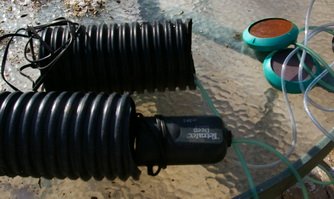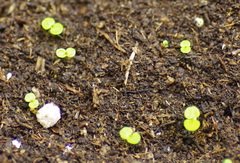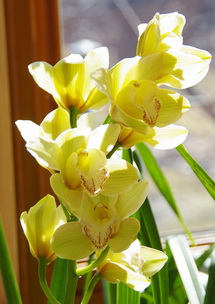| Back to Back Issues Page |
 |
|
Dallying In The Dirt, Issue #151 --- The early Cymbidiums are compensating for the early winter. November 29, 2013 |

Winter seems to have settled in here with a vengeance. Frozen ponds and snow on the ground just doesn’t seem right in the last week of November. I know that many of you see winter earlier then I do and are not about to offer me any sympathy. The wood that I was going to move from the backyard is still sitting there frozen to the ground and covered with snow. I’ll just have to put on my parka and boots and get on with the job. The ponds have been losing water, somewhere in the river or waterfall and it’s too cold to investigate so I’ve just shut down the pump about a month earlier than usual. Now I have to chop a hole in the ice and install the air bubblers. We need that fresh air going into the water to help keep the fish alive over the winter. It compensates for the gases being given off by the decomposing vegetation at the bottom and it provides a source of fresh oxygen for the fish. They also tend to keep a small hole open in the ice that allows the gases to escape.  You may recall several mentions and pictures of the amazing Begonia boliviensis that have been blooming on my garage wall for several years. Last year we tried a new variety Santa Cruz Sunset, that we grew from seed and they were a noticeable improvement over the previous ones. I noticed this summer that they were setting a lot of seed so I went out and collected few thousand seeds. That’s not as much effort as it sounds like, Begonia seed is very tiny, almost dust like, averaging 2,000,000 seeds per ounce. I carefully sowed a sample of them to see if they were viable. They are. The soil surface turned green in just over a week and now the tiny seedlings are starting to develop. The next big question is whether they come true from seed or will I get some strange Begonia progenitor. That will take a few weeks to discover. Once you learn how to handle the very tiny seeds they are quite easy to grow.
You may recall several mentions and pictures of the amazing Begonia boliviensis that have been blooming on my garage wall for several years. Last year we tried a new variety Santa Cruz Sunset, that we grew from seed and they were a noticeable improvement over the previous ones. I noticed this summer that they were setting a lot of seed so I went out and collected few thousand seeds. That’s not as much effort as it sounds like, Begonia seed is very tiny, almost dust like, averaging 2,000,000 seeds per ounce. I carefully sowed a sample of them to see if they were viable. They are. The soil surface turned green in just over a week and now the tiny seedlings are starting to develop. The next big question is whether they come true from seed or will I get some strange Begonia progenitor. That will take a few weeks to discover. Once you learn how to handle the very tiny seeds they are quite easy to grow.Time to answer a few questions. If you have a gardening question just ‘reply’ to this newsletter and send me your query. I try to answer most of the questions and the ones that I answer here are those that I think will have the widest interest. You can also find the latest garden updates on the front page of gardening-enjoyed.com. I try to change it every few days so check back often. |
| Back to Back Issues Page |
 Inside things are a bit more pleasant. The large Hibiscus that came indoors a few weeks ago, continues to bloom. In the corner of the solarium the early bright yellow
Inside things are a bit more pleasant. The large Hibiscus that came indoors a few weeks ago, continues to bloom. In the corner of the solarium the early bright yellow